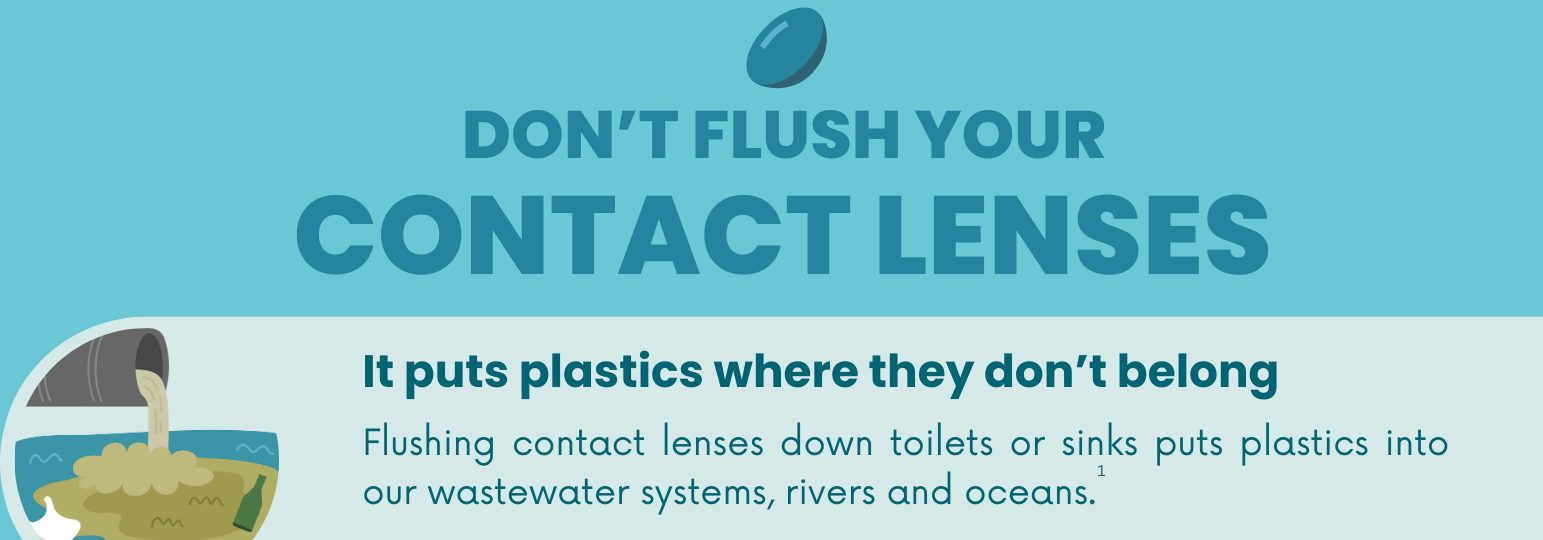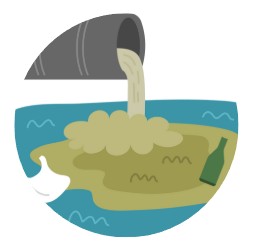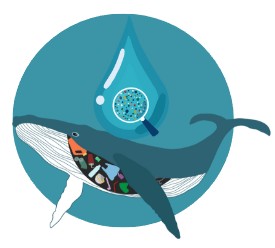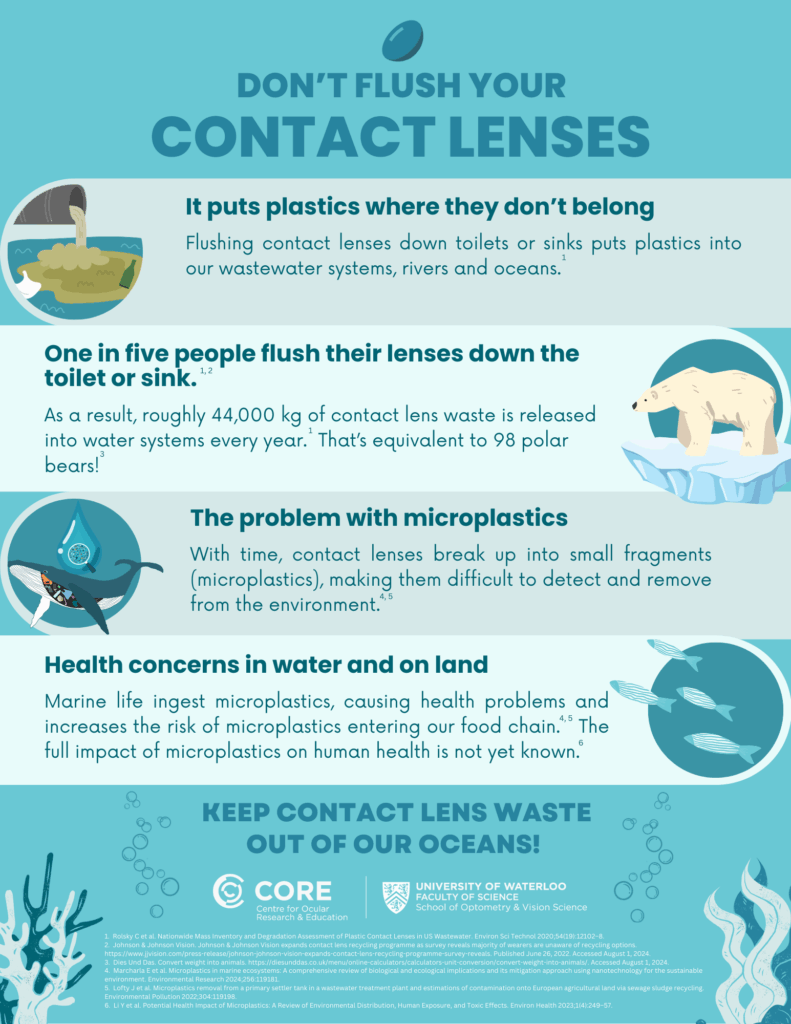
Three reasons you should not be flushing your contact lenses down the toilet or sink
One year’s worth of daily disposable contact lens wear creates about 1 kg of waste,1,2 but did you know that the lenses themselves only make up about 10 grams (or 0.1%) of the total waste?2
Even though contact lenses are small and feel like they weigh next to nothing, you might be tempted to flush them down the toilet or sink. And if you did, you wouldn’t be alone. Surveys have found about 1 in 5 contact lens wearers in the UK3 and USA4 flush their used lenses down the toilet or sink. In fact, an estimated 44,000 kg of contact lens waste is released into water systems every year as a result of flushing lenses down the toilet or sink.4 That’s equivalent to 98 polar bears!5
Here are 3 reasons why you shouldn’t flush your contact lenses down the toilet or sink.
1. It puts plastics where they don’t belong.

When flushed down the toilet or sink, contact lenses can end up in wastewater systems or directly in our oceans.4 Inappropriate disposal of contact lenses can have devasting consequences. Large and small fragments of contact lenses have been recovered from sewage sludge.4 This is worrisome, as 50% of treated sewage sludge in the US is used as fertilizer in farming, which means potentially more plastics could be introduced into the food chain.6
2. The problem with microplastics.
With time, all plastic products, including contact lenses, break up into small fragments (microplastics) making them difficult to detect and remove from the environment.7,8

3. Health concerns in water and on land.

Fragments of plastic smaller than 5mm are classed as microplastics.9,10 Studies have shown that microplastics are consumed by a wide range of marine life7,11 and it’s unclear the full extent this can have on their mortality, morbidity, and reproduction.12 This is an additional potential route for microplastics to enter our food chain, and the full impact of microplastics on human health is not yet fully known.13 There’s never been a more critical time to reflect and reduce our impact on these vulnerable aquatic ecosystems and the wider environment.
How should I throw away my contact lenses?
You have two options when it comes to throwing away your used lenses.
The best option is to save them up and drop them off in a specialist recycling bin. One provider of this service is TerraCycle. These recycling bins can be found at participating eye clinics and will accept worn lenses, plastic blister trays, and the shiny foils that package your lenses, too. Ask your eye care provider if they have a specialist recycling bin in their office, or you can find your nearest drop-off location by searching the TerraCycle website (Canada, USA).
If you find there are no drop-off locations near you, you can purchase a Zero Waste Box from TerraCycle, where a range of non-hazardous flexible or rigid plastic products can be recycled by them. When the box is full of collected materials, you ship the box off to TerraCycle who will take care of the sorting and recycling.
If neither of those options is accessible for your patient, the final option would be to simply throw them in the bin. Whatever you do, don’t flush contact lenses down the toilet or the sink.
Summary

Whether you’re new to contact lenses, or you’ve been wearing them for decades, you’ll now know why you shouldn’t flush lenses down the toilet or sink. These recycling services are fairly new and evolving, so why not ask your eye care provider if they have a bin that accepts your contact lens waste the next time you’re passing by their office.
Download this infographic (pdf / image) to learn more. Share this message with your friends and family on your social media platforms, tagging @COREEyeNews and #CLSustainability #SustainableEyecare.
See our other pages to learn how much (or little) waste is generated from wearing contact lenses and how your patients should sort and dispose of their contact lens waste.
References & Resources
1. Routhier J, Freitas MD, Hickson-Curran S. Daily disposable versus reusable contact lenses: a close match when it comes to the impact on the environment. Cont Lens Anterior Eye 2012;35:e2.
2. 2. Smith SL, Orsborn GN, Sulley A, et al. An investigation into disposal and recycling options for daily disposable and monthly replacement soft contact lens modalities. Cont Lens Anterior Eye 2022;45(2):101435.
3. Johnson & Johnson Vision. Johnson & Johnson Vision expands contact lens recycling programme as survey reveals majority of wearers are unaware of recycling options. Published June 26, 2022. Accessed April 16, 2025.
4. Rolsky C, Kelkar VP, Halden RU. Nationwide Mass Inventory and Degradation Assessment of Plastic Contact Lenses in US Wastewater. Environ Sci Technol 2020;54(19):12102–8
5. Dies Und Das. Convert weight into animals. Accessed August 1, 2024.
6. Cha J, Cupples AM. Detection of the antimicrobials triclocarban and triclosan in agricultural soils following land application of municipal biosolids. Water Res 2009;43(9):2522–30.
7. Marcharla E, Vinayagam S, Gnanasekaran L, et al. Microplastics in marine ecosystems: A comprehensive review of biological and ecological implications and its mitigation approach using nanotechnology for the sustainable environment. Environmental Research 2024;256:119181.
8. Lofty J, Muhawenimana V, Wilson CAME, et al. Microplastics removal from a primary settler tank in a wastewater treatment plant and estimations of contamination onto European agricultural land via sewage sludge recycling. Environmental Pollution 2022;304:119198.
9. United States National Oceanic and Atmospheric Administration. Microplastics. Accessed April 16, 2025.
10. European Chemicals Agency. Microplastics. Accessed April 16, 2025.
11. Nelms SE, Barnett J, Brownlow A, et al. Microplastics in marine mammals stranded around the British coast: ubiquitous but transitory? Sci Rep 2019;9(1):1075.
12. Cole M, Lindeque P, Halsband C, et al. Microplastics as contaminants in the marine environment: a review. Mar Pollut Bull 2011;62(12):2588–97.
13. Li Y, Tao L, Wang Q, et al. Potential Health Impact of Microplastics: A Review of Environmental Distribution, Human Exposure, and Toxic Effects. Environ Health 2023;1(4):249–57.




